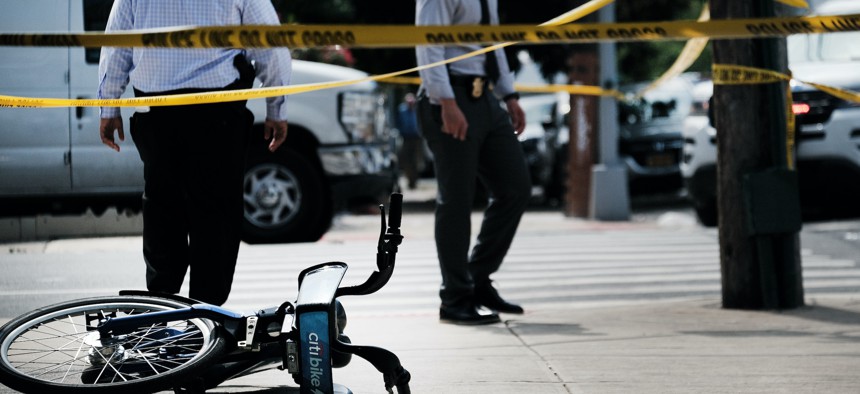Opinion
Opinion: Rising gun violence and shocking crimes require sober analysis, not knee-jerk responses
We need to invest in making New Yorkers safe, but failed punitive policies, like reinstating cash bail for low level offenses, are not the answer.

NYPD at a crime scene in Brooklyn. Spencer Platt/Getty Images
New Yorkers are reeling from a rise in gun violence, and a series of shocking violent crimes against police and subway riders. In response Mayor Eric Adams has vowed new initiatives to combat gun violence to make our subways safe.
As a diehard New Yorker, I believe both efforts deserve support. All New Yorkers deserve to feel safe, on the subway and in their communities, and right now, they don’t.
But the impulse to do something shouldn’t give way to doing anything. The danger in this moment is that city leaders and NYPD will revive the old “tough on crime” playbook without understanding what is really driving the rise in violence. In response to truly terrible incidents – the shooting of two police officers in Harlem and the murder of subway rider Michelle Go – our knee-jerk response should not be to reenact unsupported policies that have and will again negatively impact thousands.
To start, Gotham’s leaders need to focus not simply on interdiction and prosecution, but on addressing the intertwined challenges of homelessness and mental health. Both the Harlem shooting and Go’s death had their roots in mental illness. The mayor’s plan to clear the subways has a treatment component, but it is far too small. The ranks of the homeless, or as I prefer “unhoused,” exploded during COVID-19, as many people avoided virus-ridden shelters. (COVID deaths among the unhoused were estimated at 61% higher than the general population.)
Arrests shouldn’t be the end result of clearing the subways. Instead, the city must connect the unhoused to treatment for substance abuse and mental illness, create additional livable sheltering options, expand long-term housing assistance, and build or support additional affordable rental units. The latter two especially have been shown to be less expensive and more effective than short-term sheltering.
At the same time, city leaders should resist the temptation to blame the rise in gun crime on New York’s bail reform laws – an easy scapegoat, but not a real solution. The evidence just doesn’t support it.
New York’s groundbreaking cash bail reform has reduced by more than half the number of people who are jailed pending trial. The result has been massive cost savings to localities in New York (the city’s comptroller’s office estimated the cost of jailing someone at Rikers Island at $1500 per day). And it accomplished these savings without impacting public safety. Sober statistics, as opposed to fearmongering, tell the tale: 99% of those released pre-trial are not re-arrested for committing a violent felony in any subsequent month, and 97% are not re-arrested for any crime at all. Of the 3% to 5% who are rearrested, more than half are rearrested for misdemeanors.
The surge in gun crimes and murders in the city is real, but there’s no evidence that bail reform has anything to do with it. The rise in murder rates is national, not regional, and rates have risen in many large cities and states that did not reform cash bail or limit pre-trial detention. An influx of guns and the isolation and breakdown of the community safety net caused by the pandemic are more likely explanations.
Business leaders have recently called on Adams to address gun violence. I support those calls: New Yorkers have the right to move about the streets and subways without fear of violence, and gun crime threatens the New York economic miracle of the past several decades.
But any business leader knows that smart investing requires accurately assessing the landscape and the evidence. Calls to roll back bail reform and arrest and incarcerate our way out of violence misdiagnose the problem. These approaches will lead to wasted investments and further loss of life through violence or incarceration. Instead, it’s time to commit ourselves to the hard work of reducing the flow of illegal guns into the city, providing real and effective support to the unhoused, and finding non-incarcerative solutions to mental illness and addiction.

